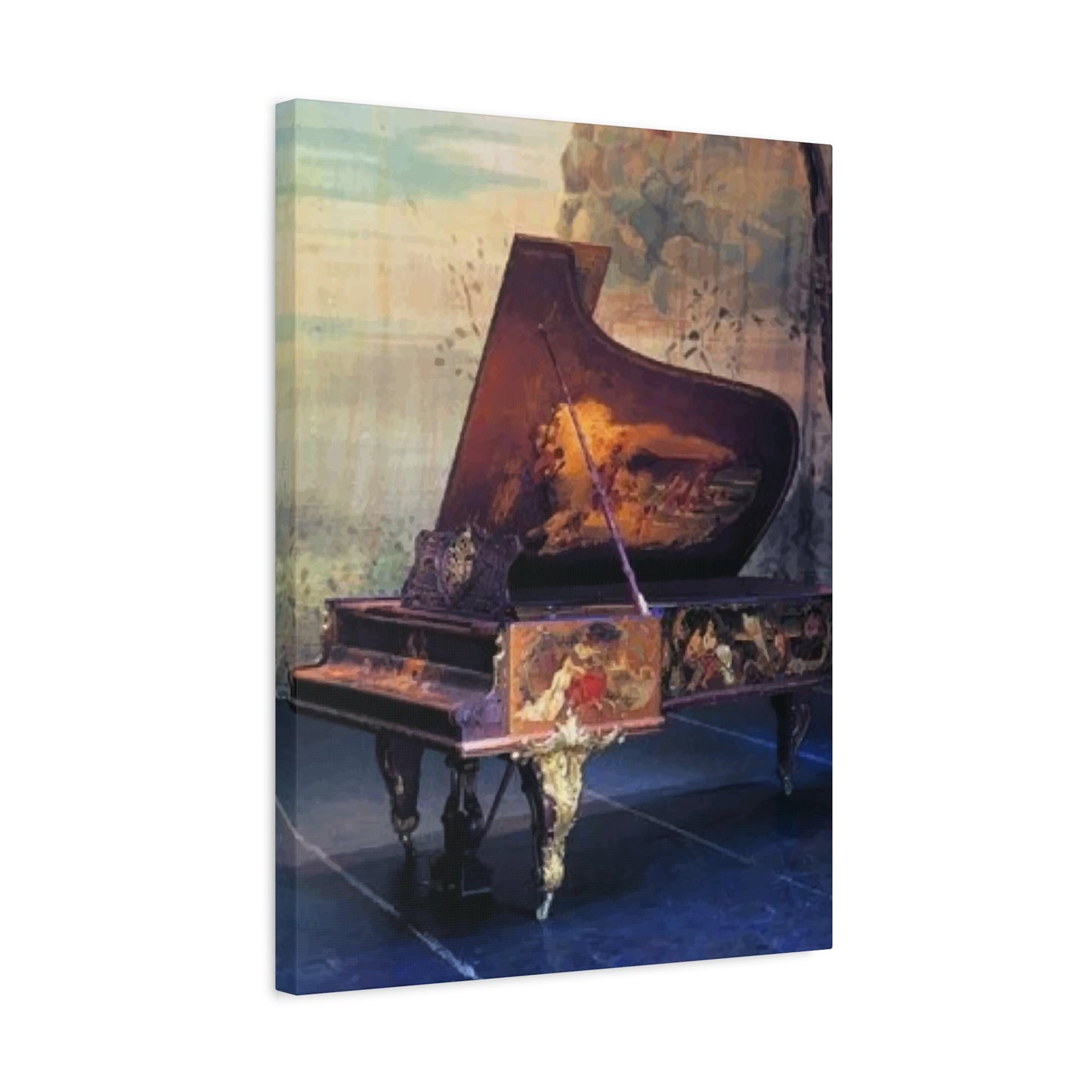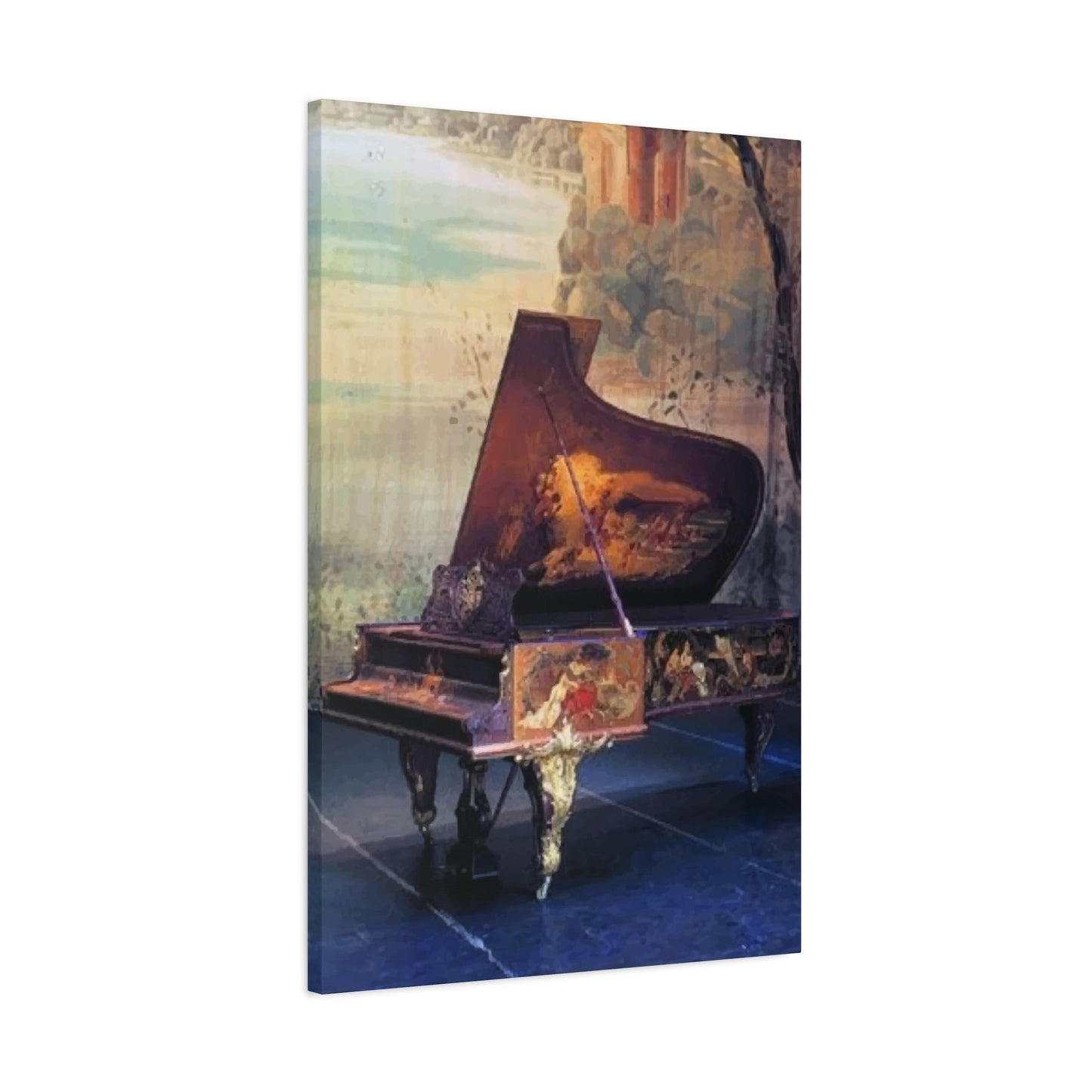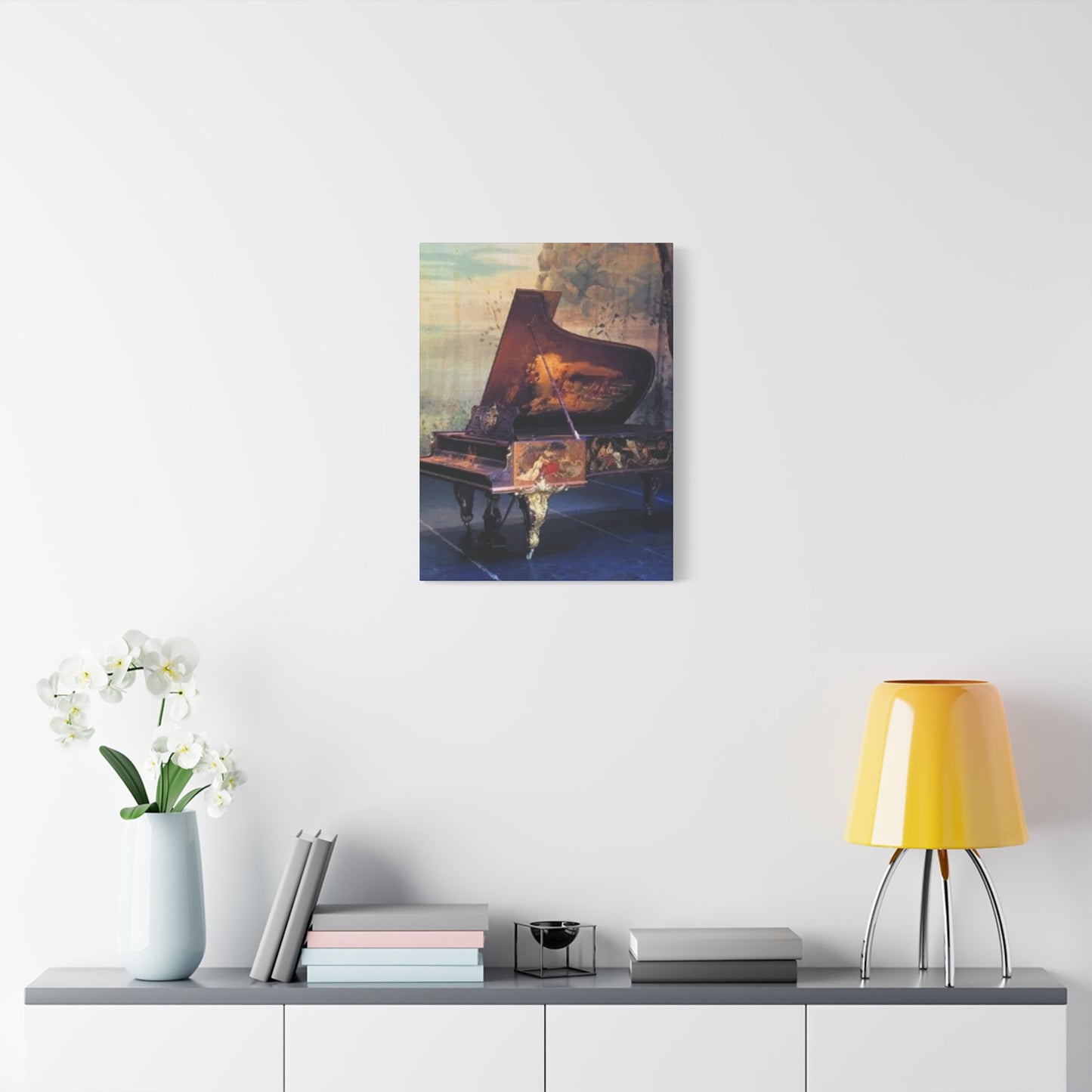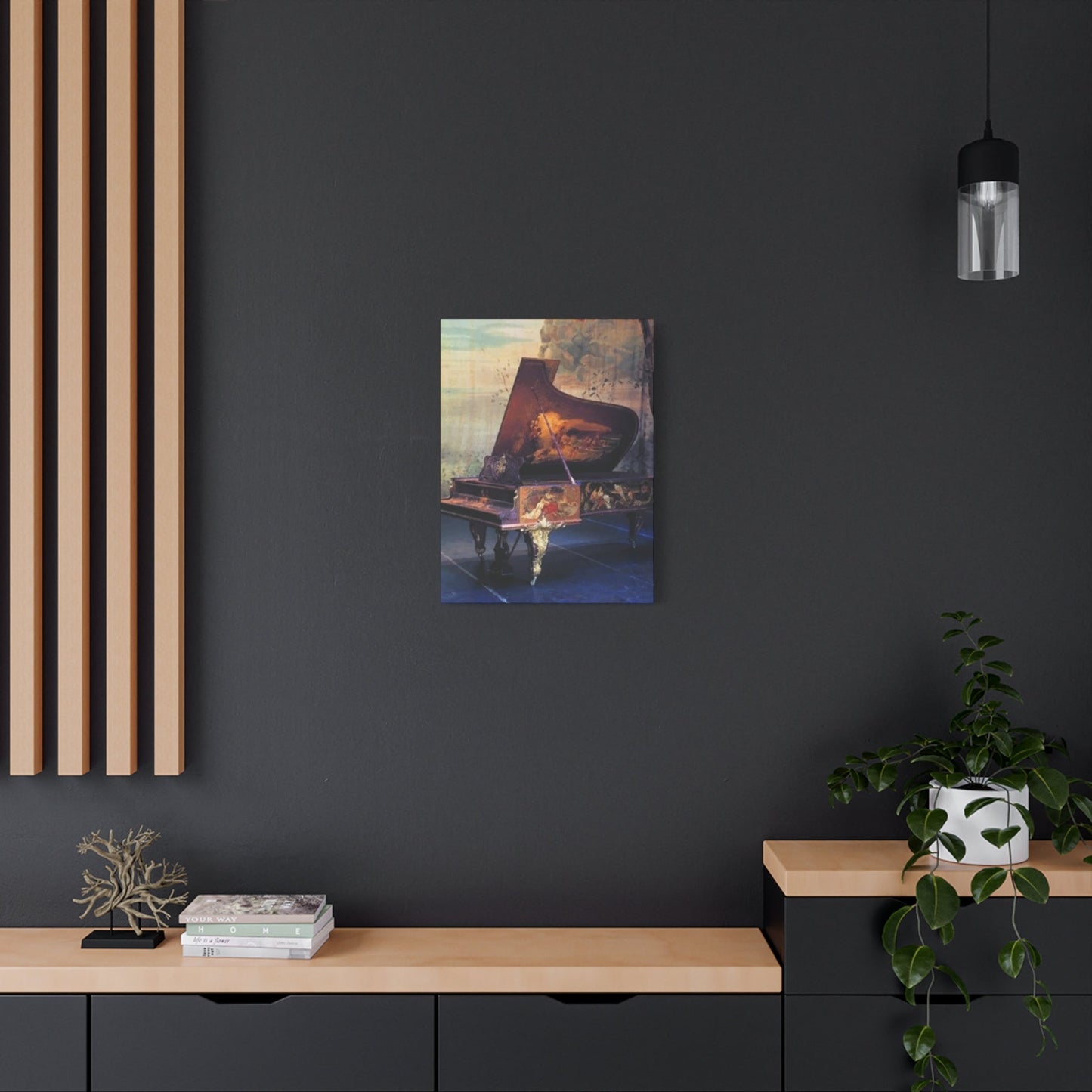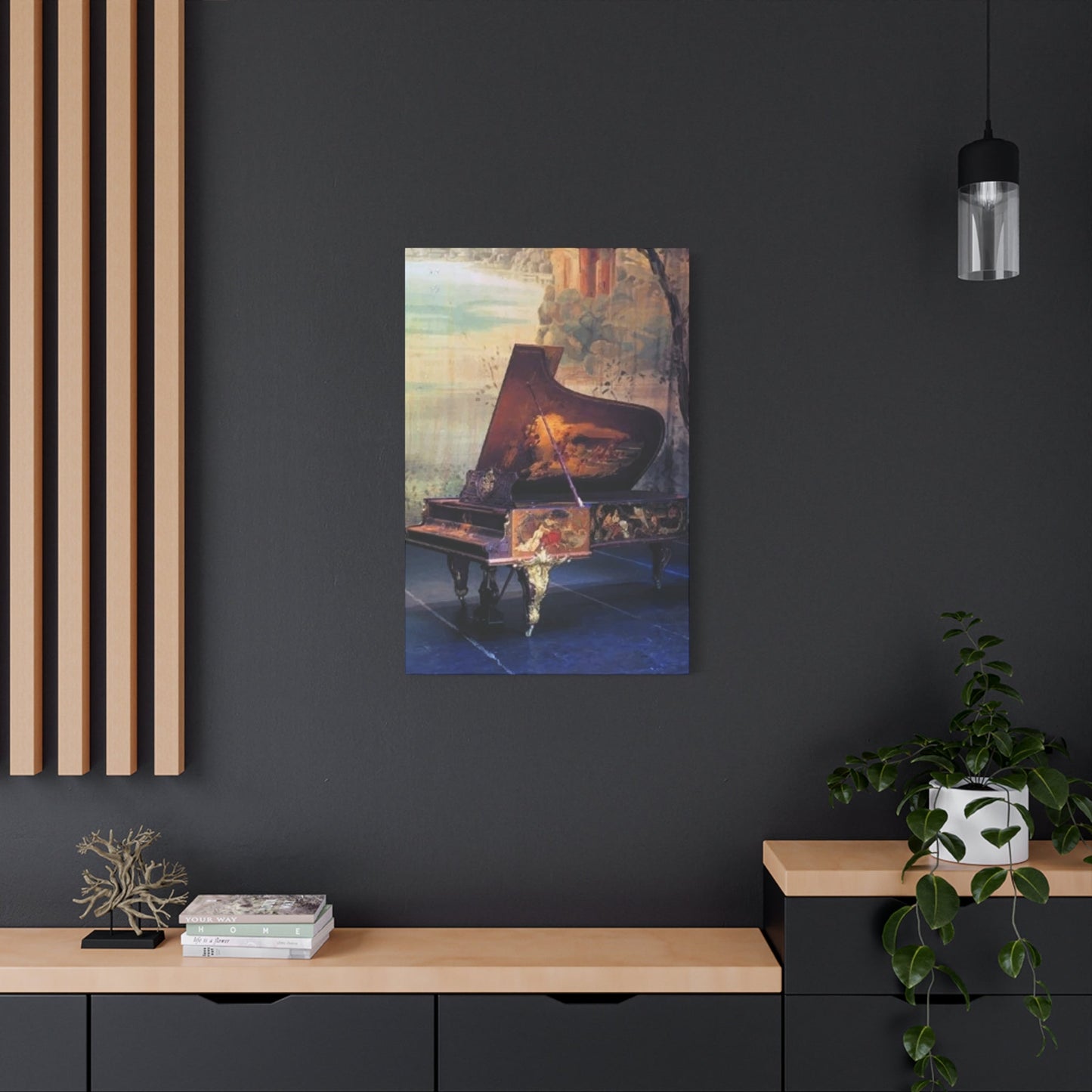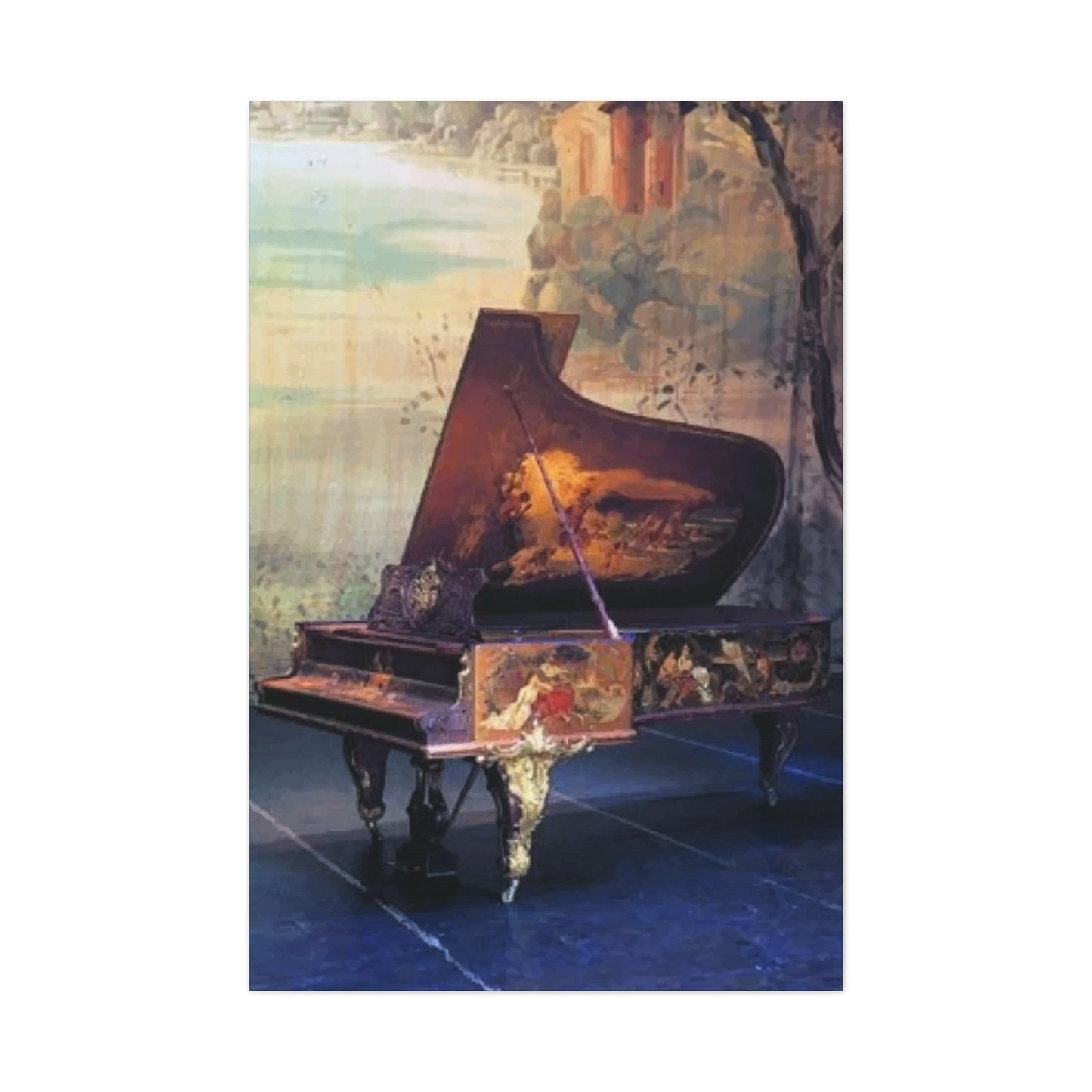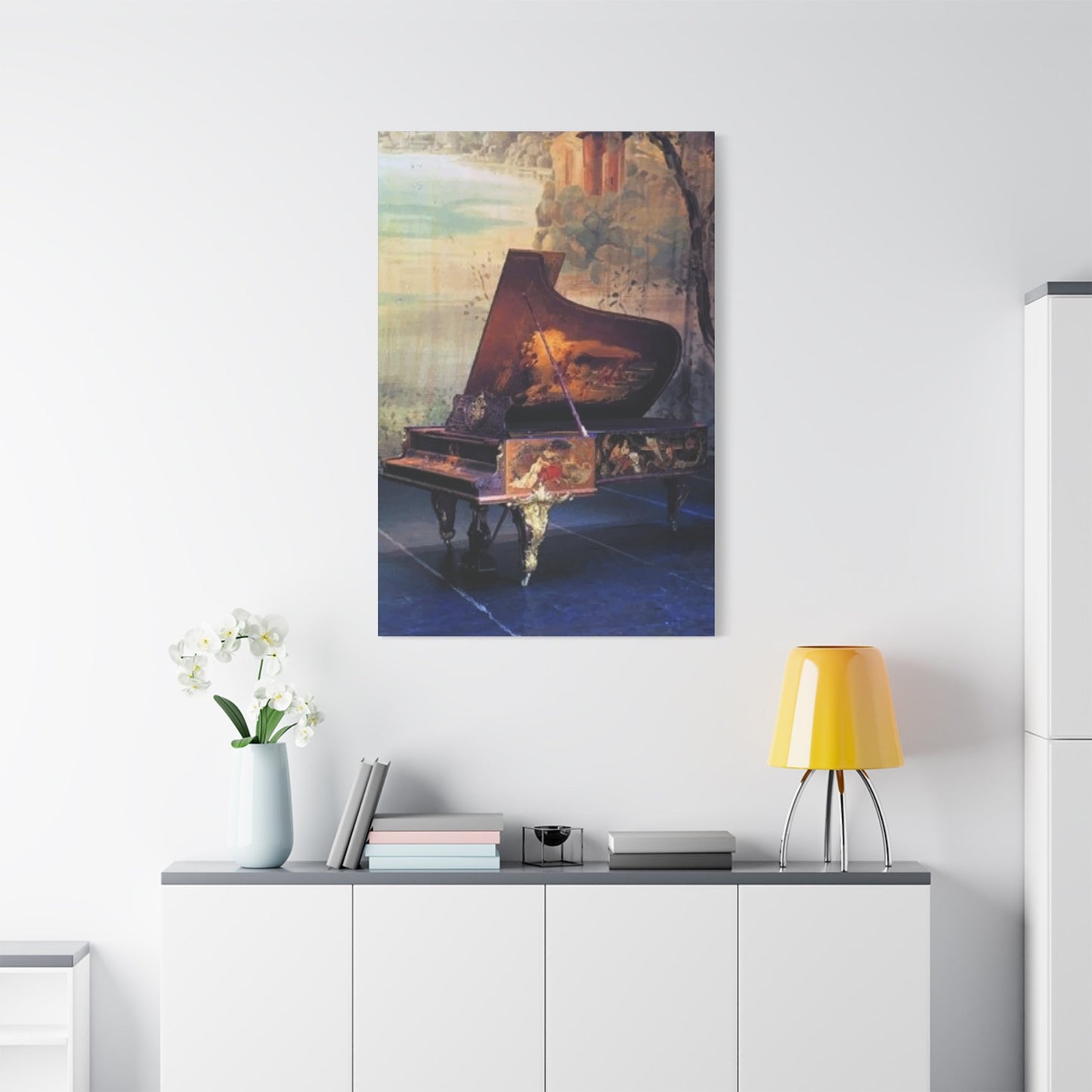Antique Grand Piano Wall Art: Sophisticated Canvas Prints That Inspire Creativity
Musical artwork has become an increasingly popular choice for homeowners seeking to create sophisticated and culturally rich living spaces. Among the most captivating options available today are canvas prints featuring grand pianos, which seamlessly blend artistic beauty with musical passion. These elegant pieces serve as more than mere wall decorations; they represent a lifestyle choice that celebrates the timeless connection between visual and auditory arts.
The allure of piano-themed wall art extends beyond its aesthetic appeal, touching the hearts of music enthusiasts, interior design aficionados, and anyone who appreciates the finer aspects of cultural expression. Whether displayed in living rooms, music studios, hallways, or private galleries, these canvas prints create an atmosphere of refinement and artistic appreciation that transforms ordinary spaces into extraordinary environments.
Harmonizing Musical Wall Decor with Contemporary Living Spaces
Creating a cohesive interior design scheme that incorporates musical wall art requires careful consideration of color palettes, existing furnishings, and overall aesthetic goals. Piano canvas prints offer remarkable versatility in this regard, as they can complement both traditional and contemporary design approaches while maintaining their distinctive character and charm.
When integrating piano artwork into modern living spaces, consider the existing color scheme and architectural elements. Black and white piano prints work exceptionally well in monochromatic or minimalist settings, providing visual interest without overwhelming the space. These classic color combinations create striking focal points that draw the eye while maintaining the clean lines and uncluttered appearance that characterize contemporary design.
For spaces with warmer color palettes, sepia-toned or vintage-style piano prints can add depth and character while harmonizing with earth tones, rich browns, and golden hues. These pieces work particularly well in rooms featuring natural materials such as wood, leather, and stone, creating a cohesive atmosphere that celebrates both musical and natural beauty.
The scale of piano canvas prints should be carefully considered in relation to wall space and surrounding furnishings. Large-format prints make bold statements and work well as centerpieces in spacious rooms with high ceilings, while smaller pieces can be grouped together to create gallery walls that tell a visual story about musical heritage and artistic appreciation.
Lighting plays a crucial role in showcasing piano wall art effectively. Natural light brings out the subtle details and textures in canvas prints, while carefully positioned accent lighting can create dramatic shadows and highlights that enhance the three-dimensional quality of the artwork. Consider installing adjustable track lighting or picture lights to illuminate your piano prints during evening hours.
The placement of musical wall art within contemporary spaces should follow established design principles while allowing for creative expression. Position larger pieces at eye level in areas where they can be appreciated without competition from other visual elements. Avoid placing piano prints directly above busy furniture arrangements or in areas with heavy traffic patterns that might detract from their artistic impact.
Showcasing Grand Piano Elegance Through Canvas Print Artistry
Grand pianos represent the pinnacle of musical instrument craftsmanship, combining functional excellence with aesthetic beauty in ways that few other objects can match. Canvas prints capturing these magnificent instruments allow homeowners to bring this elegance into their living spaces, creating visual anchors that speak to sophistication and cultural appreciation.
The artistic representation of grand pianos in canvas prints offers numerous stylistic approaches, from photorealistic depictions that showcase every detail of polished wood and gleaming hardware to impressionistic interpretations that capture the essence and emotion of these beautiful instruments. Each approach serves different design purposes and appeals to various aesthetic preferences.
Photorealistic grand piano canvas prints excel in formal settings where precision and attention to detail are valued. These pieces work particularly well in home offices, libraries, and formal living areas where their technical accuracy and visual impact can be fully appreciated. The clarity and detail in these prints create conversation pieces that invite closer examination and admiration.
Impressionistic and abstract interpretations of grand pianos offer greater flexibility in contemporary design schemes, as their artistic interpretation allows for more creative integration with existing color palettes and decorative themes. These pieces can serve as bridge elements that connect traditional musical themes with modern artistic sensibilities.
The composition of grand piano canvas prints varies significantly, with some focusing on the instrument's sweeping curves and elegant proportions, while others emphasize specific details such as keyboard patterns, pedal mechanisms, or the intricate internal structure of strings and hammers. Each compositional approach creates different emotional responses and serves different decorative purposes.
Close-up compositions that highlight keyboard details work exceptionally well in smaller spaces or as part of larger gallery arrangements. These intimate views invite contemplation and create personal connections between viewers and the musical themes they represent. The repetitive patterns of black and white keys also provide strong geometric elements that can anchor contemporary design schemes.
Wide-angle compositions showing entire grand pianos in concert hall or studio settings create more dramatic visual impact and work well as statement pieces in larger rooms. These prints often include environmental context that adds narrative depth and helps viewers imagine the musical performances and cultural experiences associated with these magnificent instruments.
Vintage Piano Artwork Concepts for Creative Music Environments
Music studios and creative spaces benefit enormously from thoughtful decoration that inspires artistic expression while maintaining professional functionality. Antique piano wall art serves both purposes beautifully, providing visual inspiration that connects contemporary musicians with the rich heritage of musical performance and composition.
Historical piano imagery offers unique advantages in studio environments, as it reminds artists of the long tradition of musical excellence they participate in with every performance or recording session. These visual connections to musical history can inspire creativity and provide perspective during challenging creative periods.
Vintage piano advertisements and sheet music covers make excellent subjects for canvas prints in music studios, combining historical interest with practical visual appeal. These pieces often feature beautiful typography and graphic design elements that reflect the aesthetic sensibilities of their respective eras, creating educational opportunities alongside their decorative functions.
Sepia-toned photographs of famous pianists at their instruments provide powerful inspirational imagery for practice rooms and studios. These historical documents capture moments of musical dedication and artistic achievement that can motivate contemporary musicians during their own creative journeys. The emotional resonance of these images often proves more powerful than purely decorative artwork.
Technical drawings and cutaway illustrations of piano mechanisms make fascinating wall art for music studios, particularly those focused on piano instruction or performance. These educational pieces satisfy curiosity about instrument construction while demonstrating the complex engineering required to create beautiful music. Such artwork appeals to both technical minds and artistic sensibilities.
Period-appropriate frames and presentation methods enhance the authenticity of vintage piano artwork in studio settings. Distressed wood frames, museum-quality matting, and professional mounting techniques help preserve the historical character of these pieces while ensuring their longevity in active creative environments.
The educational value of antique piano artwork in music studios cannot be overstated. Students and visiting musicians often spend considerable time examining these historical pieces, leading to discussions about musical evolution, performance practices, and the cultural contexts that shaped musical development. This educational aspect adds significant value beyond mere decoration.
Creating Dramatic Impact with Grand Piano Statement Pieces in Corridors
Hallways and corridors present unique opportunities for displaying grand piano canvas prints as dramatic statement pieces that create lasting impressions on residents and visitors alike. These transitional spaces often suffer from neglect in interior design, yet they offer excellent potential for showcasing artwork that sets the tone for entire homes or buildings.
The linear nature of hallways makes them ideal settings for piano canvas prints that emphasize the flowing lines and elegant proportions of grand pianos. Long, horizontal compositions work particularly well in these spaces, drawing the eye forward while creating visual continuity throughout the corridor. These pieces can effectively guide movement through the space while providing visual interest during passage.
Large-format piano canvas prints in hallways create gallery-like experiences that elevate the entire home's aesthetic profile. These statement pieces demonstrate commitment to artistic excellence and cultural appreciation, making strong first impressions on guests while providing daily inspiration for residents. The impact of a beautifully chosen and properly displayed piano print in a hallway often exceeds that of much more expensive decorative elements.
Lighting considerations become particularly important when displaying piano artwork in hallways, as these spaces often lack natural light sources. Professional lighting solutions, including adjustable track systems and individual picture lights, ensure that piano canvas prints receive appropriate illumination throughout the day and evening hours. Proper lighting not only enhances the visual impact of the artwork but also creates welcoming atmospheres in otherwise utilitarian spaces.
The acoustic properties of hallways can complement piano wall art in interesting ways, as these spaces often have unique sound characteristics that relate to the musical themes depicted in the artwork. Some homeowners choose to incorporate subtle audio elements, such as softly playing classical piano music, to create multisensory experiences that fully realize the artistic potential of their hallway galleries.
Multiple piano canvas prints can be arranged in hallways to create progressive narratives or thematic explorations of musical heritage. These arrangements might trace the evolution of piano design, showcase different performance contexts, or explore various artistic interpretations of musical themes. Such thoughtful curation transforms hallways into meaningful cultural experiences.
The durability considerations for hallway artwork differ from those for pieces displayed in more protected environments. High-traffic areas require robust mounting systems and protective measures to prevent damage from accidental contact. Professional installation and quality materials become particularly important investments when creating hallway gallery spaces.
Blending Historical Piano Art with Contemporary Interior Styles
The challenge of incorporating vintage piano artwork into contemporary interior designs requires careful balance between historical authenticity and modern aesthetic sensibilities. Successful integration creates dynamic visual tension that enhances both the historical pieces and the contemporary environment, resulting in spaces that feel both current and culturally grounded.
Contemporary minimalist interiors can benefit enormously from carefully chosen vintage piano artwork, as these pieces provide focal points and cultural depth that prevent minimalist spaces from feeling sterile or impersonal. The key lies in selecting pieces that complement rather than compete with the clean lines and uncluttered appearance that characterize minimalist design.
Color coordination becomes crucial when blending vintage piano art with contemporary interiors. Sepia tones and muted color palettes in historical pieces often work beautifully with modern neutral color schemes, while more vibrant vintage pieces can provide controlled splashes of color in otherwise monochromatic environments. The goal is to create harmony while maintaining the distinctive character of both historical and contemporary elements.
Scale relationships require careful consideration when combining vintage piano artwork with modern furniture and architectural elements. Contemporary spaces often feature bold, geometric forms that can overwhelm delicate historical pieces, while overly large vintage prints might dominate minimal contemporary furnishings. Finding the right balance requires experimentation and often benefits from professional design consultation.
Framing choices play vital roles in successfully integrating vintage piano artwork into contemporary spaces. Modern frames can update historical pieces while maintaining their authenticity, while period-appropriate frames might require coordination with contemporary elements to prevent jarring contrasts. The goal is to honor the historical character of the artwork while ensuring visual compatibility with contemporary surroundings.
Mixed-media approaches offer exciting possibilities for combining vintage piano themes with contemporary artistic techniques. Digital enhancements of historical photographs, modern interpretations of vintage sheet music, and contemporary color treatments of antique piano imagery create bridge pieces that speak to both historical and modern sensibilities.
The storytelling potential of vintage piano artwork in contemporary spaces adds narrative depth that pure contemporary decoration often lacks. These historical pieces invite contemplation about cultural continuity, artistic evolution, and the enduring power of musical expression across generations. Such depth enriches the daily experience of living in contemporary spaces.
Exploring Musical Art Styles from Traditional to Contemporary Expression
The evolution of piano artwork reflects broader changes in artistic movements, technological capabilities, and cultural values throughout history. Understanding these stylistic developments helps homeowners and designers make informed choices about which types of piano canvas prints best serve their aesthetic goals and personal preferences.
Classical artistic representations of pianos emphasize technical accuracy, formal composition, and traditional aesthetic values. These pieces often showcase the craftsmanship and engineering excellence of historical piano makers while celebrating the cultural significance of musical performance in formal settings. Classical styles work particularly well in traditional interiors and formal environments.
Romantic period artistic interpretations of piano themes focus on emotional expression, atmospheric effects, and the psychological impact of musical experience. These pieces often feature dramatic lighting, expressive brushwork, and compositions that emphasize the emotional connections between performers and their instruments. Romantic styles complement traditional and transitional interior designs.
Impressionistic approaches to piano artwork capture the essence and mood of musical themes rather than focusing on precise technical details. These pieces often feature loose brushwork, atmospheric effects, and color palettes that evoke emotional responses rather than documenting physical reality. Impressionistic piano prints work well in both traditional and contemporary settings.
Modern artistic interpretations of piano themes embrace abstract elements, experimental techniques, and contemporary aesthetic values. These pieces might deconstruct traditional piano imagery, explore geometric relationships, or investigate color theories in ways that create entirely new visual experiences. Modern piano artwork pairs beautifully with contemporary interior designs.
Contemporary digital art techniques enable artists to create piano-themed pieces that would have been impossible using traditional methods. Digital manipulation, composite imagery, and computer-generated elements expand the possibilities for piano artwork while maintaining connections to musical themes and cultural heritage.
Mixed-media approaches combine traditional and contemporary techniques to create piano artwork that speaks to multiple aesthetic sensibilities simultaneously. These pieces might incorporate historical elements with modern treatments, or traditional compositions with contemporary materials and presentation methods.
The choice between different artistic styles of piano canvas prints should consider both aesthetic preferences and functional requirements. Traditional styles provide cultural gravitas and formal beauty, while contemporary approaches offer flexibility and creative innovation. Many successful interior designs benefit from combinations of styles that create visual interest and cultural depth.
Inspiring Creative Energy Through Musical Canvas Print Selection
The psychological impact of musical artwork in living and working spaces has been documented by numerous studies in environmental psychology and interior design research. Piano canvas prints, in particular, have demonstrated remarkable abilities to inspire creative thinking, reduce stress levels, and enhance overall well-being in residential and professional environments.
The visual representation of musical instruments creates subconscious associations with harmony, rhythm, and creative expression that can positively influence mood and productivity. Piano imagery specifically evokes connections to classical music, cultural refinement, and artistic achievement that inspire viewers to pursue their own creative goals and appreciate beauty in their daily lives.
Color psychology plays a significant role in how piano artwork affects viewers' emotional and creative responses. Black and white compositions create feelings of sophistication and clarity, while warmer color palettes in vintage-style pieces evoke nostalgia and emotional depth. Understanding these psychological effects helps in selecting piano canvas prints that support specific creative goals.
The placement of inspirational piano artwork in home offices, studios, and creative spaces requires careful consideration of workflow patterns and visual sight lines. Pieces positioned where they can be viewed during brief breaks from focused work provide mental refreshment without causing distraction, while larger statement pieces create inspiring environments that support extended creative sessions.
Personal connections to musical themes enhance the inspirational value of piano canvas prints. Musicians naturally respond to imagery of their instruments, while non-musicians often develop emotional connections to pieces that represent cultural aspirations or childhood memories of musical education. These personal resonances multiply the positive impact of musical artwork.
The educational aspects of historically themed piano canvas prints contribute to their inspirational value by connecting viewers with the rich heritage of musical achievement and cultural development. Learning about the contexts and stories behind vintage piano imagery creates deeper appreciation and stronger emotional connections to the artwork.
Seasonal rotation of piano canvas prints can maintain their inspirational impact over time while accommodating changing moods and creative needs. Different pieces for different seasons or creative projects prevents habituation and ensures that the artwork continues to provide fresh inspiration and visual interest.
Thoughtful Gift Selection: Musical Wall Art for Music Enthusiasts
Piano canvas prints make exceptional gifts for musicians, music teachers, students, and anyone who appreciates the cultural significance of musical expression. The personal nature of musical interests requires careful consideration when selecting pieces that will resonate with individual recipients while serving practical decorative functions.
Professional musicians often appreciate piano artwork that reflects their performance experiences and artistic aspirations. Concert hall photography, historical instrument documentation, and artistic interpretations of performance contexts create meaningful connections to their professional lives while providing beautiful decoration for homes and studios.
Music educators benefit from piano canvas prints that combine aesthetic beauty with educational value. Historical development sequences, technical diagrams, and period-appropriate imagery support their teaching missions while creating inspiring classroom and studio environments. These pieces often become focal points for discussions about musical history and cultural development.
Piano students of all ages respond enthusiastically to artwork that celebrates their chosen instrument and encourages continued study and practice. Age-appropriate pieces that emphasize the beauty and cultural importance of piano performance can provide daily motivation and reinforce the value of musical education.
Music therapy professionals often utilize visual elements, including piano artwork, to support their therapeutic goals. Carefully chosen pieces that evoke positive emotional responses and support relaxation can enhance the effectiveness of music therapy sessions while creating welcoming treatment environments.
Gift presentation considerations include professional framing, appropriate sizing for intended display spaces, and accompanying materials that explain the historical or artistic significance of the chosen pieces. These thoughtful touches demonstrate understanding of the recipient's interests while ensuring that the gifts will be properly appreciated and displayed.
Customization options for piano canvas prints allow gift-givers to create truly unique pieces that reflect specific relationships with recipients. Personal photographs of recipients with pianos, custom color treatments of standard designs, and personalized text additions create one-of-a-kind gifts that will be treasured for years.
Strategic Placement Guidelines for Piano Canvas Print Display
The successful display of piano canvas prints requires understanding of basic design principles, lighting considerations, and viewing patterns that ensure maximum visual impact while maintaining harmony with existing interior elements. Strategic placement decisions can dramatically affect both the aesthetic success of the artwork and its practical integration into daily life.
Eye-level positioning remains the fundamental guideline for hanging piano canvas prints, with adjustments made for seating areas where viewing heights differ from standing positions. In spaces where both standing and seated viewing occur regularly, compromise positions that work reasonably well for both perspectives provide the most practical solutions.
Wall space considerations include not only the dimensions of available areas but also the relationships between artwork and surrounding elements such as furniture, windows, doors, and architectural features. Piano canvas prints should enhance rather than compete with these elements while maintaining their own visual integrity and impact.
Grouping strategies for multiple piano canvas prints require careful attention to visual balance, thematic coherence, and spacing relationships. Gallery wall arrangements work well for collections of related pieces, while symmetrical groupings provide formal balance in traditional settings. Asymmetrical arrangements can create dynamic visual interest in contemporary spaces.
Traffic flow patterns affect both the placement and protection of piano canvas prints in active areas of homes and buildings. High-traffic zones require sturdy mounting systems and protective considerations, while more secluded areas allow for delicate pieces that might be vulnerable to accidental damage in busier locations.
Natural light sources can dramatically enhance the visual impact of piano canvas prints, but they also pose potential conservation risks over time. Positioning artwork to take advantage of favorable natural lighting while avoiding direct sunlight requires careful analysis of seasonal sun patterns and window orientations.
Artificial lighting solutions, including track lighting, picture lights, and accent fixtures, allow for precise control over how piano canvas prints are illuminated throughout different times of day and seasons. Professional lighting design can transform good artwork into spectacular focal points while providing flexibility for different occasions and moods.
Harmonious Integration of Sound and Visual Arts in Home Design
The relationship between auditory and visual arts creates opportunities for sophisticated interior design approaches that appeal to multiple senses simultaneously. Piano canvas prints serve as natural focal points for design schemes that celebrate this relationship while creating environments that support both musical performance and visual appreciation.
Acoustic considerations in rooms featuring piano artwork often influence both placement decisions and design choices for surrounding elements. Hard surfaces that might create sound reflections could affect both musical performance and conversation quality, while soft furnishings and acoustic treatments can enhance both sound quality and visual comfort.
Multi-sensory design approaches incorporate both visual piano artwork and carefully selected audio elements to create immersive environments that celebrate musical culture. Background classical piano music played at appropriate volumes can enhance the impact of visual piano themes while creating atmospheres that support relaxation and contemplation.
The psychological connections between visual and auditory musical experiences suggest that piano canvas prints can enhance appreciation for musical performance even when no actual music is present. The visual reminders of musical beauty and cultural heritage create mental associations that enrich daily experiences and support personal cultural development.
Cultural continuity becomes an important consideration when designing spaces that honor musical heritage through both visual and auditory elements. Piano artwork can serve as bridge elements that connect contemporary living with historical musical traditions, creating environments that feel both current and culturally grounded.
Technology integration allows for sophisticated combinations of visual piano artwork with digital audio systems that can provide appropriate musical accompaniment for different occasions and moods. Smart home systems can coordinate lighting, music, and even climate control to enhance the impact of musical artwork in residential settings.
Selecting Appropriate Scale and Aesthetic Style for Piano Canvas Art
The success of piano canvas prints in interior design depends heavily on appropriate scale relationships with surrounding architectural elements and furnishings. Understanding how different sizes and styles work in various settings enables informed decision-making that maximizes both aesthetic impact and practical integration.
Small-format piano canvas prints work exceptionally well in intimate settings such as home offices, reading nooks, and bedroom areas where close viewing distances allow appreciation of fine details. These pieces can be grouped together to create gallery arrangements or used as accent elements within larger decorative schemes.
Medium-sized prints offer versatility for most residential applications, providing sufficient visual impact to serve as focal points while maintaining proportional relationships with standard furniture and architectural elements. These sizes work particularly well over mantels, in dining areas, and as centerpieces for living room arrangements.
Large-format piano canvas prints make bold statements that work best in spacious rooms with high ceilings and uncluttered walls. These dramatic pieces can anchor entire room designs while creating gallery-quality focal points that demonstrate serious commitment to artistic excellence and cultural appreciation.
Panoramic and extra-wide formats capitalize on the naturally horizontal lines of grand pianos while creating unique visual experiences that work particularly well in hallways, above long furniture pieces, and in contemporary spaces with clean geometric lines. These unusual proportions often create more memorable impressions than standard rectangular formats.
Style considerations encompass not only artistic approach but also color palettes, compositional elements, and cultural references that must harmonize with existing interior design themes. Traditional styles work best with classical and transitional interiors, while contemporary interpretations integrate more easily with modern design schemes.
Establishing Piano Wall Art as Central Design Elements
Creating rooms where piano canvas prints serve as central design elements requires careful coordination of all decorative and functional elements to support and enhance the artistic focal points. This approach demands more commitment than simply adding artwork to existing spaces, but it produces more cohesive and impactful results.
Color scheme development should begin with careful analysis of the dominant colors in chosen piano canvas prints, then extend these palettes throughout the room using complementary and analogous color relationships. This approach creates visual harmony while allowing the artwork to maintain its central importance in the overall design.
Furniture selection and arrangement should support rather than compete with piano artwork for visual attention. Clean-lined pieces in neutral tones often work best as supporting elements, while more decorative furniture might overwhelm the artistic focal points or create visual confusion.
Lighting design becomes particularly critical when piano canvas prints serve as central elements, as these pieces must be properly illuminated to maintain their visual dominance throughout different times of day and various usage patterns. Professional lighting consultation often proves valuable for achieving optimal results.
Supporting decorative elements should enhance rather than duplicate the musical themes established by piano artwork. Complementary art pieces, musical instruments, sheet music, and cultural artifacts can create rich thematic environments without overwhelming the primary focal points.
Window treatments, floor coverings, and architectural elements should be chosen to support the overall aesthetic established by the central piano artwork while maintaining their own functional requirements. Neutral approaches often work best, allowing the artwork to provide the primary visual interest and color impact.
Creating Atmospheric Enhancement Through Strategic Musical Canvas Placement
The atmospheric impact of piano canvas prints extends beyond their immediate visual effects to influence the overall mood, energy level, and cultural character of interior spaces. Understanding these atmospheric effects enables strategic placement decisions that maximize the positive impact of musical artwork on daily life experiences.
Emotional resonance varies significantly among different types of piano imagery, with some pieces promoting relaxation and contemplation while others inspire energy and creative activity. Matching these emotional qualities to intended room functions creates environments that naturally support desired activities and moods.
Cultural atmosphere creation through piano artwork requires understanding of the historical and social associations connected to different types of musical imagery. Classical concert hall scenes evoke formal cultural experiences, while intimate piano practice scenarios suggest personal artistic development and private musical enjoyment.
Seasonal adaptability becomes important for artwork that will remain in place throughout the year, as different seasonal moods might require different atmospheric support. Piano canvas prints with neutral seasonal associations maintain their appropriateness year-round, while pieces with strong seasonal character might benefit from periodic rotation.
Daily rhythm considerations acknowledge that different times of day might benefit from different atmospheric qualities. Morning energy might be supported by bright, energetic piano imagery, while evening relaxation could benefit from more subdued and contemplative pieces.
Social dynamics in spaces with piano artwork often reflect the cultural associations of musical performance and appreciation. These pieces can encourage conversation about cultural interests while creating shared reference points for social interaction and cultural exchange.
Incorporating Piano Art into Simplified and Traditional Interior Approaches
The integration of piano canvas prints into both minimalist and traditional interior design approaches requires different strategies while maintaining respect for the distinctive characteristics of each design philosophy. Successful integration enhances both the artwork and the interior design approach while creating coherent and satisfying visual experiences.
Minimalist integration focuses on the essential visual qualities of piano artwork while eliminating unnecessary decorative elements that might diminish the impact of carefully chosen pieces. The stark beauty of black and white piano imagery often aligns perfectly with minimalist aesthetic values while providing necessary visual interest and cultural depth.
Traditional integration emphasizes the historical and cultural associations of piano artwork while coordinating with established design elements such as period furniture, classical architectural details, and formal arrangement principles. These approaches often benefit from groupings of related pieces and traditional presentation methods.
Color palette coordination requires different approaches for minimalist and traditional settings, with minimalist spaces benefiting from limited color schemes that emphasize the inherent contrasts in piano imagery, while traditional spaces can accommodate richer color palettes that complement the warm tones often found in period furnishings and architectural elements.
Scale relationships differ between minimalist and traditional approaches, with minimalist settings often benefiting from bold, single statement pieces that create focal points in uncluttered environments, while traditional settings can accommodate multiple pieces and more complex arrangements that reflect classical decorative principles.
Lighting solutions must support both the artwork and the overall design approach, with minimalist settings often benefiting from simple, unobtrusive lighting systems that highlight the artwork without adding visual clutter, while traditional settings can accommodate more elaborate lighting fixtures that complement period-appropriate decorative schemes.
Curating Collections of Historical Grand Piano Artwork for Residential Galleries
The development of comprehensive collections of antique grand piano wall art requires systematic approaches that consider historical accuracy, artistic quality, and thematic coherence while maintaining practical considerations for residential display and preservation. Successful collections tell visual stories about musical development and cultural heritage.
Historical research forms the foundation of serious collecting efforts, as understanding the contexts and significance of different periods and styles enables informed acquisition decisions and meaningful collection development. This research also provides the knowledge necessary for proper presentation and interpretation of collected pieces.
Authenticity verification becomes increasingly important as collections develop value and significance, requiring expertise in identifying genuine historical pieces versus modern reproductions. Professional appraisal and authentication services provide necessary documentation while protecting collectors from costly mistakes.
Thematic development strategies help create coherent collections that tell meaningful stories about musical history and cultural development. Collections might focus on specific time periods, geographical regions, piano manufacturers, or musical venues while maintaining sufficient variety to sustain long-term interest.
Conservation considerations become critical for valuable historical pieces, requiring appropriate environmental controls, professional framing materials, and careful handling procedures to ensure long-term preservation. Investment in proper conservation often proves worthwhile for significant pieces.
Display rotation strategies allow large collections to be enjoyed fully over time while preventing damage from continuous exposure. Systematic rotation schedules ensure that all pieces receive appropriate exhibition time while allowing for seasonal variations and special focus periods.
Documentation and cataloging provide essential records for insurance purposes, family heritage preservation, and eventual estate planning considerations. Professional documentation also enhances the educational and cultural value of collections while supporting their preservation for future generations.
Professional Installation Techniques for Premium Musical Wall Art
The proper installation of piano canvas prints requires attention to both technical and aesthetic considerations that ensure secure mounting while maximizing visual impact. Professional installation techniques protect valuable artwork while creating display conditions that enhance rather than diminish artistic impact.
Wall analysis must consider both structural capabilities and surface conditions before attempting installation of heavy or valuable piano canvas prints. Different wall types require different mounting approaches, while surface irregularities might affect the appearance of precisely aligned artwork.
Hardware selection depends on artwork weight, wall type, and desired adjustability for future repositioning. Professional-grade hanging systems often provide better security and adjustability than standard picture hanging hardware while maintaining clean appearances that don't detract from artistic presentation.
Leveling and alignment techniques ensure that single pieces and groups of piano canvas prints create satisfying visual relationships while avoiding the distracting effects of crooked or poorly aligned artwork. Professional tools and techniques achieve results that are difficult to match with standard household equipment.
Lighting coordination often requires electrical work that should be performed by qualified professionals to ensure safety and code compliance. Proper lighting installation can transform the impact of piano artwork while providing reliable illumination that enhances rather than damages the pieces over time.
Environmental considerations include humidity control, temperature stability, and protection from direct sunlight that could cause fading or other damage over time. Professional installation often includes recommendations for environmental modifications that protect artwork investments.
Insurance and documentation requirements for valuable piano canvas prints often specify professional installation and regular maintenance inspections. Meeting these requirements protects both the physical artwork and the financial investments they represent while ensuring proper coverage in case of damage or loss.
Psychological Benefits of Musical Visual Arts in Living Spaces
Research in environmental psychology demonstrates significant benefits from incorporating musical themed artwork into residential and workplace environments. Piano canvas prints specifically provide visual connections to cultural achievement and artistic excellence that support psychological well-being and personal development.
Stress reduction effects result from the calming associations most people have with classical music and the refined cultural environments where piano performance typically occurs. These positive associations create subconscious relaxation responses that can help counteract the stresses of daily life while supporting mental health and emotional balance.
Cognitive enhancement benefits include improved focus, enhanced creativity, and increased appreciation for cultural refinement that can influence personal development and social interactions. The presence of meaningful artwork encourages contemplative thinking and aesthetic appreciation that enriches daily experiences.
Cultural identity development receives support from visual reminders of artistic heritage and musical achievement. Piano artwork connects residents with broader cultural narratives while supporting personal interests in musical appreciation and cultural participation.
Social interaction enhancement occurs as piano artwork provides conversation topics and shared cultural references that facilitate meaningful social connections. These pieces often serve as icebreakers and relationship builders in social situations while demonstrating cultural interests and aesthetic preferences.
Memory stimulation and emotional processing benefits result from the rich associative networks connected to musical themes and artistic expression. Piano imagery can trigger positive memories while supporting emotional regulation and psychological processing of life experiences.
Maintenance and Preservation Strategies for Canvas Print Collections
Proper maintenance and preservation of piano canvas prints ensures their long-term beauty while protecting financial investments and cultural significance. Understanding appropriate care techniques prevents damage while maintaining the visual impact that makes these pieces valuable additions to interior design schemes.
Regular cleaning procedures must balance the need to remove dust and environmental pollutants with the risk of damage from inappropriate cleaning methods or materials. Professional conservation guidelines provide safe approaches for different types of canvas prints while avoiding common mistakes that can cause irreversible damage.
Environmental control measures include monitoring and controlling humidity levels, temperature fluctuations, and air quality factors that can affect canvas materials and printed surfaces over time. Simple monitoring equipment and environmental adjustments can dramatically extend the life of valuable artwork.
UV protection strategies prevent fading and other light damage that represents one of the most common threats to canvas prints. Proper window treatments, UV-filtering glazing, and appropriate artificial lighting choices provide protection while maintaining the visual accessibility that makes artwork enjoyable.
Handling procedures for moving, cleaning, and maintaining piano canvas prints require careful attention to proper techniques that prevent physical damage from oils, pressure, or accidental contact. Training all household members in proper handling procedures protects collections from well-intentioned but potentially damaging interventions.
Documentation of condition changes, maintenance activities, and environmental exposures provides valuable information for insurance purposes while helping identify potential problems before they become serious. Photographic records of artwork condition support insurance claims while assisting professional conservators when restoration becomes necessary.
Professional conservation services become necessary when damage occurs or when valuable pieces require expert attention to maintain their condition and value. Establishing relationships with qualified conservators before problems arise ensures access to appropriate expertise when needed while supporting informed decision-making about conservation investments.
Economic Considerations in Piano Canvas Print Investment and Collection
The financial aspects of acquiring and maintaining piano canvas prints involve both immediate purchase decisions and long-term value considerations that affect both aesthetic satisfaction and financial planning. Understanding these economic factors supports informed decision-making while maximizing both artistic enjoyment and financial prudence.
Price range considerations encompass everything from affordable reproductions suitable for casual decoration to investment-quality pieces that represent significant financial commitments. Understanding the factors that influence pricing helps buyers make appropriate choices for their budgets and objectives while avoiding costly mistakes.
Value retention factors include artist reputation, print quality, edition size, historical significance, and market demand trends that affect both immediate satisfaction and long-term value prospects. These considerations become particularly important for larger financial investments and serious collecting activities.
Authentication and provenance documentation significantly affect both current value and future appreciation prospects for piano canvas prints. Professional appraisal and documentation services provide essential protection for valuable pieces while supporting informed buying and selling decisions.
Insurance considerations include coverage for theft, damage, and loss as well as documentation requirements that many policies specify for valuable artwork. Understanding insurance requirements before acquisition prevents coverage gaps while protecting financial investments in piano artwork collections.
Market trend analysis helps collectors and decorators understand timing considerations for acquisitions while identifying emerging opportunities and potential value appreciation prospects. Professional art market resources provide valuable information for serious collectors and investors.
Estate planning implications for valuable piano canvas print collections require consideration of tax consequences, family heritage preservation, and disposal strategies that maximize benefits for heirs while minimizing tax liabilities. Professional estate planning advice becomes important for significant collections.
Conclusion
Piano canvas prints represent a sophisticated fusion of musical appreciation and visual artistry that enriches interior spaces while celebrating the cultural heritage of musical performance. These elegant artworks serve multiple purposes simultaneously, functioning as decorative elements, cultural statements, and sources of daily inspiration that enhance the quality of residential and professional environments.
The versatility of piano-themed wall art allows for successful integration into virtually any interior design approach, from minimalist contemporary spaces to traditional formal settings. Whether serving as dramatic focal points or subtle accent elements, these pieces demonstrate remarkable adaptability while maintaining their distinctive character and cultural significance. The key to successful integration lies in understanding both the artistic qualities of individual pieces and the design principles that govern their effective presentation.
The psychological and cultural benefits of incorporating musical artwork into living spaces extend far beyond mere decoration. Piano canvas prints create visual connections to the rich heritage of musical achievement while supporting creative thinking, stress reduction, and cultural appreciation in daily life. These benefits justify the investment in quality pieces while ensuring that the aesthetic pleasure they provide continues to enrich residents' lives over many years.
Professional installation, proper maintenance, and thoughtful placement decisions maximize both the visual impact and longevity of piano canvas print investments. Understanding these technical aspects ensures that beautiful artwork receives the care and presentation it deserves while protecting financial investments and cultural significance for future generations.
The market for piano canvas prints offers options for every budget and aesthetic preference, from affordable reproductions that provide immediate decorative satisfaction to investment-quality pieces that combine artistic excellence with long-term value appreciation. This diversity ensures that anyone can incorporate musical themes into their interior design while making financially appropriate choices for their circumstances.
Collection development strategies allow enthusiasts to build comprehensive displays that tell meaningful stories about musical history and cultural development. Whether focusing on specific periods, styles, or themes, thoughtful collecting creates environments that serve educational purposes while providing increasing aesthetic satisfaction as collections mature and develop.
The future of piano canvas prints in interior design appears bright, as growing appreciation for cultural heritage and artistic excellence continues to drive demand for meaningful artwork that transcends mere decoration. These pieces represent investments in both aesthetic pleasure and cultural participation that enrich daily life while supporting broader appreciation for musical arts.
For homeowners, designers, and cultural enthusiasts seeking to create interior spaces that reflect sophisticated aesthetic values and cultural appreciation, piano canvas prints offer unmatched opportunities to achieve these goals while maintaining practical functionality and design flexibility. The enduring appeal of musical themes ensures that these artistic choices remain relevant and satisfying throughout changing design trends and personal evolution.
The integration of piano artwork into contemporary living represents more than aesthetic choice; it demonstrates commitment to cultural continuity and artistic excellence that influences both personal development and social interaction. These visual connections to musical heritage create daily reminders of humanity's greatest cultural achievements while inspiring continued appreciation and participation in artistic traditions.













